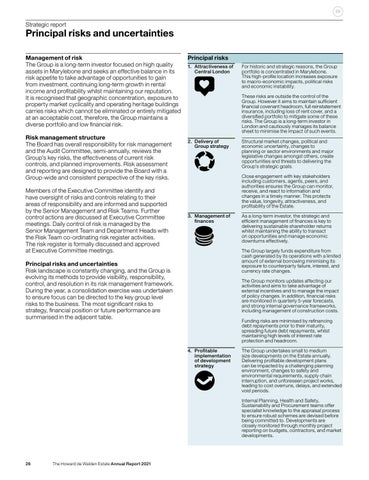26
Strategic report
Principal risks and uncertainties Management of risk The Group is a long-term investor focused on high quality assets in Marylebone and seeks an effective balance in its risk appetite to take advantage of opportunities to gain from investment, continuing long-term growth in rental income and profitability whilst maintaining our reputation. It is recognised that geographic concentration, exposure to property market cyclicality and operating heritage buildings carries risks which cannot be eliminated or entirely mitigated at an acceptable cost, therefore, the Group maintains a diverse portfolio and low financial risk. Risk management structure The Board has overall responsibility for risk management and the Audit Committee, semi-annually, reviews the Group’s key risks, the effectiveness of current risk controls, and planned improvements. Risk assessment and reporting are designed to provide the Board with a Group-wide and consistent perspective of the key risks. Members of the Executive Committee identify and have oversight of risks and controls relating to their areas of responsibility and are informed and supported by the Senior Management and Risk Teams. Further control actions are discussed at Executive Committee meetings. Daily control of risk is managed by the Senior Management Team and Department Heads with the Risk Team co-ordinating risk register activities. The risk register is formally discussed and approved at Executive Committee meetings.
Principal risks 1. Attractiveness of Central London
For historic and strategic reasons, the Group portfolio is concentrated in Marylebone. This high-profile location increases exposure to macro-economic impacts, political risks and economic instability. These risks are outside the control of the Group. However it aims to maintain sufficient financial covenant headroom, full reinstatement insurance, including loss of rent cover, and a diversified portfolio to mitigate some of these risks. The Group is a long-term investor in London and cautiously manages its balance sheet to minimise the impact of such events.
2. Delivery of Group strategy
Structural market changes, political and economic uncertainty, changes to planning or sector environments and major legislative changes amongst others, create opportunities and threats to delivering the Group’s strategic goals. Close engagement with key stakeholders including customers, agents, peers, and authorities ensures the Group can monitor, receive, and react to information and changes in a timely manner. This protects the value, longevity, attractiveness, and profitability of the Estate.
3. Management of finances
As a long-term investor, the strategic and efficient management of finances is key to delivering sustainable shareholder returns whilst maintaining the ability to transact on opportunities and manage economic downturns effectively. The Group largely funds expenditure from cash generated by its operations with a limited amount of external borrowing minimising its exposure to counterparty failure, interest, and currency rate changes.
Principal risks and uncertainties Risk landscape is constantly changing, and the Group is evolving its methods to provide visibility, responsibility, control, and resolution in its risk management framework. During the year, a consolidation exercise was undertaken to ensure focus can be directed to the key group level risks to the business. The most significant risks to strategy, financial position or future performance are summarised in the adjacent table.
The Group monitors updates affecting our activities and aims to take advantage of external incentives and to manage the impact of policy changes. In addition, financial risks are monitored in quarterly 5-year forecasts, and strong internal governance frameworks, including management of construction costs. Funding risks are minimised by refinancing debt repayments prior to their maturity, spreading future debt repayments, whilst maintaining high levels of interest rate protection and headroom. 4. Profitable implementation of development strategy
The Group undertakes small to medium size developments on the Estate annually. Delivering profitable development plans can be impacted by a challenging planning environment, changes to safety and environmental requirements, supply chain interruption, and unforeseen project works, leading to cost overruns, delays, and extended void periods. Internal Planning, Health and Safety, Sustainability and Procurement teams offer specialist knowledge to the appraisal process to ensure robust schemes are devised before being committed to. Developments are closely monitored through monthly project reporting on budgets, contractors, and market developments.
26
The Howard de Walden Estate Annual Report 2021
